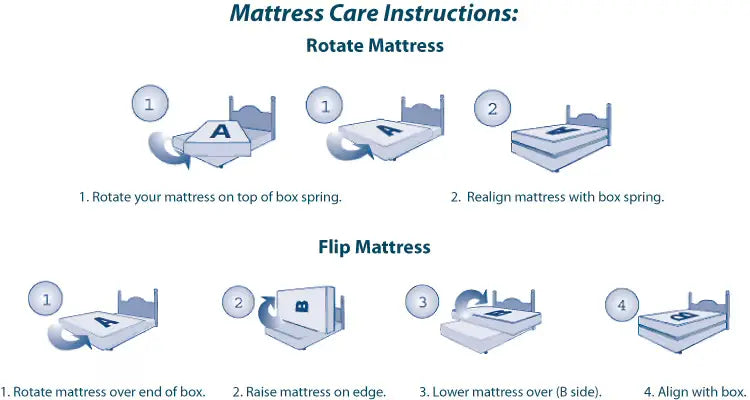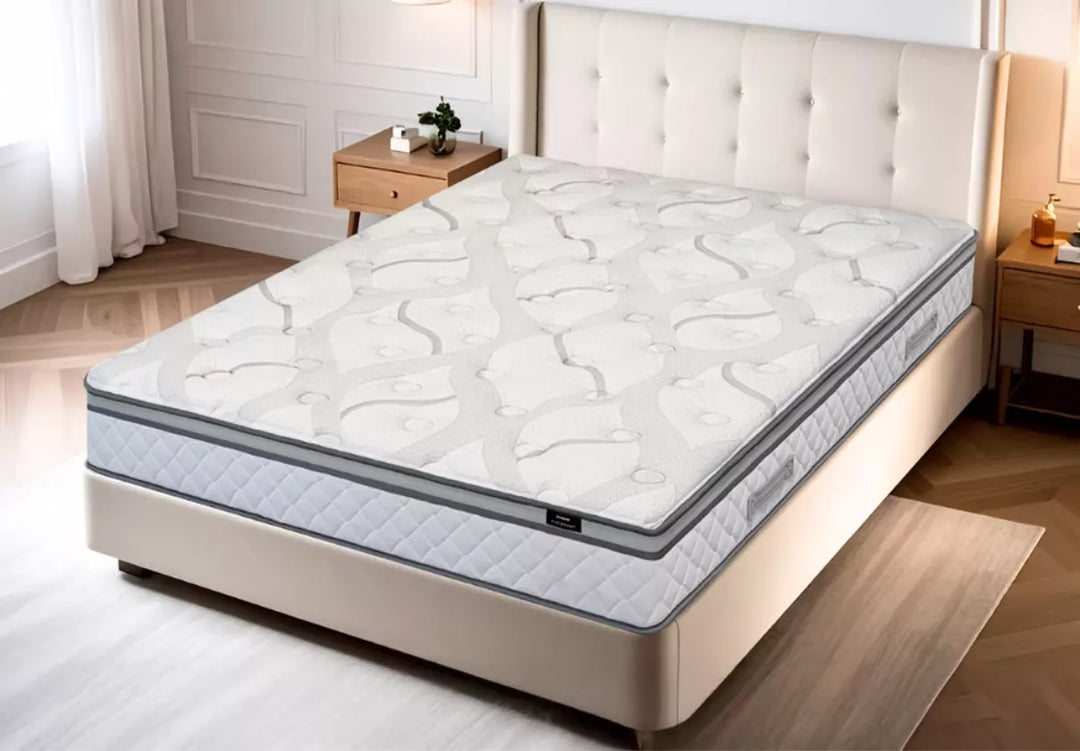
How to Rotate or Flip a Mattress
Regularly rotating or flipping your mattress offers several benefits that contribute to its longevity and your overall sleep quality. First and foremost, rotating or flipping helps distribute the weight and pressure evenly across the mattress surface. This prevents excessive wear and sagging in specific areas, ensuring that you continue to enjoy optimal support and comfort. By rotating or flipping, you can also minimise the development of body impressions, which can occur over time in frequently used areas of the mattress. Additionally, flipping a double-sided mattress can help prevent the mattress from becoming lopsided, as both sides experience equal usage.
Overall, these maintenance practices contribute to extending the lifespan of your mattress, allowing you to maximise your investment. Furthermore, by maintaining the integrity of the mattress, rotating or flipping can promote better sleep posture, spinal alignment, and alleviate pressure points, resulting in improved sleep quality and a more rejuvenating rest. So, don't overlook the benefits of these simple yet effective maintenance techniques, and make them a part of your regular mattress care routine.
How Often Should I Rotate My Mattress?
The frequency of rotating your mattress depends on its type and usage. As a general guideline, it is recommended to rotate your mattress every three to six months. However, specific recommendations may vary depending on the manufacturer's instructions or the type of mattress you have.
If you have a double-sided mattress, rotating it every three to four months can help distribute the weight and pressure evenly across the surface, preventing excessive wear and sagging in specific areas. This rotation ensures that both sides of the mattress experience equal usage.
For single-sided mattresses, rotating them can still be beneficial, although flipping is not possible. By rotating the mattress, you can minimize the development of body impressions and promote even wear.
It's important to note that some mattresses may have specific instructions from the manufacturer regarding rotation frequency, so it's always advisable to consult the care guidelines provided with your mattress.
Ultimately, regular rotation helps maintain the integrity of your mattress, prolongs its lifespan, and promotes optimal comfort and support. By incorporating this simple maintenance task into your routine, you can enhance the longevity and performance of your mattress.
Why Should I Rotate My Mattress?
Rotating your mattress on a regular basis offers several benefits that contribute to its longevity and your overall sleep experience. Here are some reasons why you should rotate your mattress:
- Even wear distribution: By rotating your mattress, you ensure that the weight and pressure are distributed evenly across its surface. This helps prevent excessive wear and sagging in specific areas, such as the middle or the sides of the mattress. Even wear distribution helps maintain the mattress's supportive properties and extends its lifespan.
- Minimise body impressions: Body impressions can develop over time in the areas where you sleep, as the materials in the mattress adjust to your body shape and weight. By rotating the mattress, you minimise the development of deep body impressions in one specific area, ensuring a more even sleep surface.
- Enhanced comfort and support: Regularly rotating your mattress helps maintain its original level of comfort and support. It prevents the formation of uneven areas and dips, which can affect your sleep posture and spinal alignment. By keeping the mattress surface more even, you promote a more comfortable and supportive sleep environment.
- Sleep quality improvement: A well-maintained mattress contributes to better sleep quality. By rotating your mattress, you can alleviate pressure points, reduce discomfort, and promote proper spinal alignment. This can result in a more restful and rejuvenating sleep experience.
- Prolonged mattress lifespan: Proper rotation helps evenly distribute the wear and tear on your mattress, reducing the chances of premature deterioration. By extending the lifespan of your mattress, you can get more value out of your investment and delay the need for a replacement.
Do I Need to Rotate My Mattress or Flip It - Or Both?
Rotate: Rotating involves turning the mattress 180 degrees, so the head becomes the foot. This is recommended for both single-sided and double-sided mattresses. Rotating helps distribute the weight and pressure evenly, minimising wear and sagging in specific areas. It is generally recommended to rotate your mattress every three to six months.
Flip: Flipping involves turning the mattress over completely, so the bottom side becomes the top. This is applicable only to double-sided mattresses. Flipping helps even out wear and extends the lifespan of the mattress. However, not all mattresses are designed to be flipped. Many modern mattresses are single-sided, with specific top and bottom sides, and flipping them may not be necessary or recommended. Always check the manufacturer's instructions to determine if your mattress is flippable.
Both: Some mattresses are designed to be both rotatable and flippable. In this case, you would rotate the mattress periodically to even out wear and sagging and then flip it over to maintain even wear on both sides. This practice is particularly common with older or traditional double-sided mattresses.

What If One Person Is Much Heavier Than The Other?
When one person is significantly heavier than the other, it's important to take special care when rotating the mattress to ensure even wear and longevity. Here are a few suggestions:
- Rotate more frequently: Consider rotating the mattress more often than the recommended frequency. Instead of rotating every three to six months, consider rotating every two to three months. This will help distribute the weight more evenly and prevent excessive sagging or indentation on one side of the mattress.
- Reinforce support: If the weight difference is significant, you may want to consider additional support options. Adding a mattress topper or using supportive bedding materials, such as extra firm pillows or mattress supports, can help evenly distribute weight and provide enhanced support to accommodate the heavier individual.
- Consider a mattress with targeted support: Look for mattresses that offer zoned or targeted support. These mattresses have varying firmness levels in different areas to provide better support where it's needed most. This can help alleviate the pressure and minimize the impact of weight disparities.
- Individual side rotation: If the weight difference is localized to one side of the mattress, you can consider rotating only the side where the heavier individual sleeps. This allows for more targeted weight distribution and can help maintain even wear on that particular side.
Can I Flip My Memory Foam Mattress?
In most cases, memory foam mattresses are not designed to be flipped. Unlike traditional spring mattresses, memory foam mattresses have a specific construction that includes comfort layers and support layers. The top comfort layer is usually made of memory foam, which conforms to your body shape for pressure relief and comfort.
Flipping a memory foam mattress would mean reversing its layers, placing the support layer on top, which would result in an uncomfortable sleep surface. Additionally, memory foam mattresses are typically designed with a non-slip bottom surface to keep them securely in place on the bed frame.
However, rotating a memory foam mattress is recommended to promote even wear and prolong its lifespan. Rotating involves turning the mattress 180 degrees, so the head becomes the foot. This helps distribute the weight and pressure evenly across the surface of the mattress, reducing the risk of sagging and indentations.
It's important to check the specific care instructions provided by the manufacturer for your memory foam mattress, as there may be variations in design and recommendations. Following the manufacturer's guidelines will ensure you properly care for your memory foam mattress and maintain its performance over time.
How Often Should You Rotate Your Mattress for Optimal Comfort?
It’s generally recommended to rotate your mattress every three to six months. This helps ensure even wear and pressure distribution, keeping your mattress comfortable and supportive for longer. If you're using a mattress topper, rotating it as well can help maintain the comfort level across the entire sleeping surface.Can Rotating Your Mattress Improve Sleep Quality?
Yes, rotating your mattress can improve sleep quality. By evenly distributing wear, it helps prevent body impressions and uneven support, leading to better spinal alignment and more comfortable sleep. Regular rotation ensures the surface remains even and supportive, helping you get a better night's rest.
What Is the Best Method for Rotating a Mattress?
The best method to rotate a mattress is to turn it 180 degrees, so the head becomes the foot of the bed. This ensures even weight distribution. Make sure to lift the mattress carefully to avoid straining your back, and try to rotate it on a regular schedule to maintain its comfort.
Can Rotating a Mattress Help Prevent Body Impressions?
Yes, rotating your mattress regularly can help prevent the formation of body impressions. When you rotate the mattress, you distribute the pressure more evenly, preventing certain areas from becoming more compressed than others, which can lead to body impressions over time.
Should I Rotate My Mattress If It's Used by Two People with Different Weights?
If two people with different weights are using the same mattress, rotating it more frequently (every two to three months) can help balance out the wear. This ensures that one side doesn't get more compressed than the other, reducing the chances of uneven wear and sagging.
How Do I Know If My Mattress Is Single-Sided or Double-Sided?
Check the label or manufacturer's instructions to determine whether your mattress is single-sided or double-sided. A single-sided mattress typically has a top and bottom layer, while a double-sided mattress can be flipped. Double-sided mattresses often have handles on both sides to make flipping easier.
What Is the Difference Between Rotating and Flipping a Mattress?
Rotating involves turning the mattress 180 degrees, so the head becomes the foot, which is recommended for both single-sided and double-sided mattresses. Flipping, on the other hand, means turning the mattress over completely so the bottom side becomes the top, and it’s only necessary for double-sided mattresses.
How Do I Flip a Mattress Correctly Without Damaging It?
To flip a mattress correctly, lift it from the edges or handles (if provided) and turn it over slowly. Make sure to avoid dragging the mattress, which can damage the fabric or structure. If the mattress is heavy, consider asking for assistance to prevent injury or damage.
Should I Use a Mattress Protector When Rotating or Flipping My Mattress?
Yes, using a mattress protector is a good idea when rotating or flipping your mattress. It helps protect the mattress from dust, dirt, and spills, and keeps it in better condition over time. Ensure the protector fits well so that it doesn’t shift during the rotation process.
Can Rotating My Mattress Prolong Its Lifespan?
Yes, rotating your mattress regularly helps extend its lifespan by ensuring even distribution of weight and pressure. This minimizes the risk of sagging, indentations, and uneven wear, keeping your mattress comfortable for a longer period and delaying the need for a replacement.
Why Does My Mattress Feel Uneven After Rotating It?
If your mattress feels uneven after rotation, it could be due to pre-existing wear or body impressions. In some cases, a mattress may have specific comfort zones that become more pronounced with use. Consider rotating it more frequently or using a mattress topper to address any discomfort.
Can Rotating or Flipping My Mattress Make It Feel Firmer or Softer?
Rotating or flipping your mattress may affect how firm or soft it feels, as it can help even out wear. If certain areas have softened more than others due to frequent use, flipping or rotating can help restore a more uniform feel, though it may not drastically change the overall firmness.
What to Do If Your Mattress Is Starting to Sag Even After Rotating or Flipping It?
If your mattress is sagging despite regular rotation or flipping, it may be nearing the end of its lifespan. You can try adding a mattress topper to improve comfort, but it's also a sign that the mattress may need to be replaced if it’s no longer providing adequate support.
Are There Any Signs That My Mattress Needs to Be Replaced Despite Rotating It Regularly?
Signs that your mattress may need to be replaced include persistent sagging, lumps, discomfort during sleep, and visible damage. If rotating the mattress no longer improves comfort or support, it might be time to invest in a new one to ensure proper rest and spinal alignment.
How to Handle Mattresses with Handles When Rotating or Flipping Them?
If your mattress has handles, use them for easier handling when rotating or flipping. Avoid pulling or tugging on the handles excessively, as this can cause them to tear. Handles are designed to help with the process, but always lift from the edges to prevent damage.
Can Rotating or Flipping Your Mattress Improve Back Pain?
Rotating or flipping your mattress can improve comfort and spinal alignment, which may alleviate some types of back pain. However, if your mattress has already lost its support or has significant wear, it might be time to consider replacing it for better back support.





